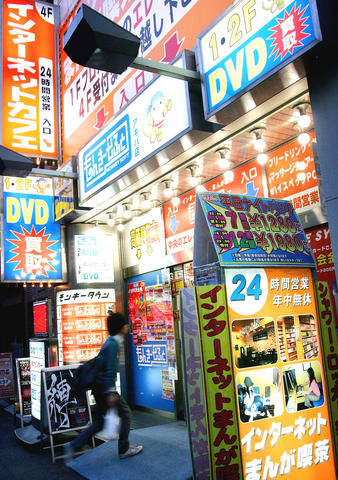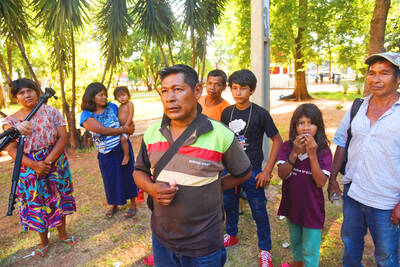It's almost midnight as Ryo settles into a reclining chair for the night, a can of tea and a pack of cigarettes at his side, a construction job awaiting him in the morning.
For the time being, this cramped cubicle at an Internet cafe -- with its TV and flickering PC monitor -- is home.
Ryo, who refused to give his full name, is part of what experts believe is a new social stratum in Japan: poor, young people who live out of 24-hour Internet cafes.

PHOTO: AP
Though there are no reliable numbers, experts warn a growing number of younger Japanese are sleeping in Net cafes like Ichigo, where the 30-year-old Ryo spends five nights a week. He stays with a friend on weekends.
The rising number of "Internet cafe refugees," as they are known, has raised enough concern that the Health Ministry is preparing to study the 1,300 Internet cafes nationwide.
Last year, 13 people contracted tuberculosis at an Internet cafe just west of Tokyo that health officials suspect originated from the cafe's homeless population, Tomohiro Uchino of the Health Ministry's social welfare department said.
phenomenon
"The phenomenon raises many issues in terms of health, labor and welfare," Uchino said. "The problem is that we don't yet have an accurate picture of how many homeless people there are in Internet cafes, how they got there, or how the government can intervene."
Behind the rise of Net refugees is Japan's ballooning population of young people who hop from one temporary job to the next.
They are believed to number more than 2 million -- a byproduct of the economic crisis that hit Japan a decade ago, as well as a shift in values in a younger generation less ready to conform to the corporate work ethic of their parents and grandparents.
Ryo said part of the reason he ended up homeless was an expensive interest in reggae music. In his twenties, he staged reggae events with his friends and even took trips to Los Angeles to study with musicians there. But then his savings ran dry.
In a city where a studio apartment rarely costs less than ¥100,000 (US$825) a month, the cafes appeal to people like Ryo.
cubicle
At Ichigo, clients pay ¥100 an hour for a small cubicle equipped with a reclining chair, computer and TV. Many cafes offer free refills of soft drinks; some even have showers. But the air is stale with cigarette smoke and there is a constant whine of computers, TVs and ventilation fans.
The urban refugees are modern-day versions of the day laborers of Osaka and other big Japanese cities who fueled the tumultuous economic growth of the 1960s -- an underclass that lodged in cheap hostels and who were rounded up each morning to work at nearby construction sites.
Some inhabitants of Net cafes also find work by the day, albeit in a more technology-savvy way. Many rely on their cellphones to arrange casual jobs, said Makoto Yuasa, who heads a homeless support center in Tokyo.
The arrangement means workers are not required to provide a set address, Yuasa said. However, the casual nature of the work means such workers often receive minimal wages and no training, social security or health insurance.
"With some job agencies, you get a call or an e-mail the night before, telling you where to turn up to work the next day," Yuasa said. "Many are menial cleaning or factory jobs that don't lead anywhere."
A government survey released earlier this year found about 18,500 homeless people across Japan, mostly aged 40 or older. That was down 27 percent from a similar survey four years ago. But the Net cafe refugees signal the existence of hidden forms of homelessness in Japan, especially among younger people, Yuasa said.
The young homeless also congregate in all-night saunas and the more traditional flophouses, where the older homeless people able to afford lodging are more likely to be found.
Young people have even been spotted catching up on sleep at the nation's 900 McDonald's restaurants open round-the-clock, according to local media reports. The media has dubbed them "McRefugees."
"We don't think this is a big problem at this point," a spokesman at McDonald's Holdings Company Japan said.
"Our staff patrol stores at night and close off unneeded sections, and people who look like they are using our stores only to sleep are sometimes asked to leave," he said.

MULTIFACETED: A task force has analyzed possible scenarios and created responses to assist domestic industries in dealing with US tariffs, the economics minister said The Executive Yuan is tomorrow to announce countermeasures to US President Donald Trump’s planned reciprocal tariffs, although the details of the plan would not be made public until Monday next week, Minister of Economic Affairs J.W. Kuo (郭智輝) said yesterday. The Cabinet established an economic and trade task force in November last year to deal with US trade and tariff related issues, Kuo told reporters outside the legislature in Taipei. The task force has been analyzing and evaluating all kinds of scenarios to identify suitable responses and determine how best to assist domestic industries in managing the effects of Trump’s tariffs, he

TIGHT-LIPPED: UMC said it had no merger plans at the moment, after Nikkei Asia reported that the firm and GlobalFoundries were considering restarting merger talks United Microelectronics Corp (UMC, 聯電), the world’s No. 4 contract chipmaker, yesterday launched a new US$5 billion 12-inch chip factory in Singapore as part of its latest effort to diversify its manufacturing footprint amid growing geopolitical risks. The new factory, adjacent to UMC’s existing Singapore fab in the Pasir Res Wafer Fab Park, is scheduled to enter volume production next year, utilizing mature 22-nanometer and 28-nanometer process technologies, UMC said in a statement. The company plans to invest US$5 billion during the first phase of the new fab, which would have an installed capacity of 30,000 12-inch wafers per month, it said. The

Taiwan’s official purchasing managers’ index (PMI) last month rose 0.2 percentage points to 54.2, in a second consecutive month of expansion, thanks to front-loading demand intended to avoid potential US tariff hikes, the Chung-Hua Institution for Economic Research (CIER, 中華經濟研究院) said yesterday. While short-term demand appeared robust, uncertainties rose due to US President Donald Trump’s unpredictable trade policy, CIER president Lien Hsien-ming (連賢明) told a news conference in Taipei. Taiwan’s economy this year would be characterized by high-level fluctuations and the volatility would be wilder than most expect, Lien said Demand for electronics, particularly semiconductors, continues to benefit from US technology giants’ effort

In a small town in Paraguay, a showdown is brewing between traditional producers of yerba mate, a bitter herbal tea popular across South America, and miners of a shinier treasure: gold. A rush for the precious metal is pitting mate growers and indigenous groups against the expanding operations of small-scale miners who, until recently, were their neighbors, not nemeses. “They [the miners] have destroyed everything... The canals, springs, swamps,” said Vidal Britez, president of the Yerba Mate Producers’ Association of the town of Paso Yobai, about 210km east of capital Asuncion. “You can see the pollution from the dead fish.